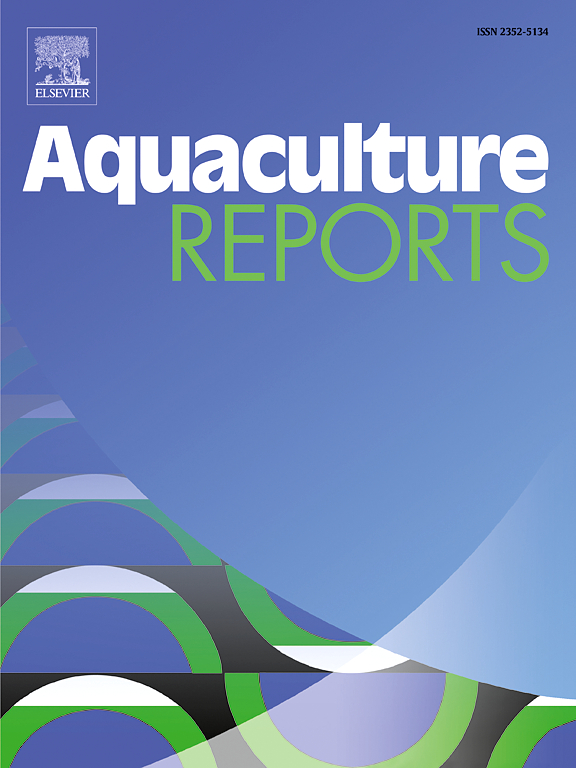沙底物的粒度对沙鱼(Holothuria scabra Jaeger 1833)幼鱼的生长、存活、消化酶谱和肠道组织学有显著影响
IF 3.7
2区 农林科学
Q1 FISHERIES
引用次数: 0
摘要
本研究旨在确定适合沙鱼幼鱼饲养的沙粒大小。12个容器,59 cmx 47 cm x 37 cm,每个容器放入30只幼鱼作为实验动物。幼鱼初始平均湿重为2.22 ± 0.43 g。处理是不同的沙粒大小作为基质:小,中,大,没有基质作为对照。以日生物量的2% %投喂底栖生物90 d。测定特定生长率、存活率、酶活性和肠道剖面。最后青少年的平均重量小,介质,和大型沙粒大小和控制5.85 ±0.52 g, 4.00±0.37 g, 3.74±0.45 g和3.69 ±0.43 g,分别。小沙粒的生长速度最快(P <; 0.05)。沙粒处理与对照的成活率差异有统计学意义(P <; 0.05)。与其他处理和对照相比,小沙粒处理的酶活性最高,绒毛长度最长。通过优化酶活性和允许绒毛吸收更多食物,小沙粒作为底物是生长幼沙鱼的理想选择。本文章由计算机程序翻译,如有差异,请以英文原文为准。
Grain sizes of sand substrates significantly influence the growth, survival, digestive enzyme profiles, and gut histology of sandfish (Holothuria scabra Jaeger 1833) juveniles during cultivation
This study aimed to determine suitable sand grain sizes as substrates for rearing sandfish juveniles. Twelve containers, 59 cm× 47 cm x 37 cm, and 30 juveniles were put into each as experimental animals. The initial mean wet weight of juveniles was 2.22 ± 0.43 g. Treatments were different sand grain sizes as substrates: small, medium, large, and without substrate as a control. Juveniles were fed with benthos at 2 % of daily biomass for 90 days. Specific growth and survival rates, enzyme activities, and intestine profiles were measured. The final mean weight of the juveniles in small, medium, and large sand grains sizes and control were 5.85 ± 0.52 g, 4.00 ± 0.37 g, 3.74 ± 0.45 g, and 3.69 ± 0.43 g, respectively. Small sand grain sizes show The fastest growth rate (P < 0.05). Survival rates between sand grain size treatments and control were significantly different (P < 0.05). The small sand grain sizes treatment showed the highest enzyme activity and longest villi sizes compared to other treatments and controls. Small sand grain sizes as the substrate are ideal for growing juvenile sandfish by optimizing the enzyme activities and allowing villi to absorb more food.
求助全文
通过发布文献求助,成功后即可免费获取论文全文。
去求助
来源期刊

Aquaculture Reports
Agricultural and Biological Sciences-Animal Science and Zoology
CiteScore
5.90
自引率
8.10%
发文量
469
审稿时长
77 days
期刊介绍:
Aquaculture Reports will publish original research papers and reviews documenting outstanding science with a regional context and focus, answering the need for high quality information on novel species, systems and regions in emerging areas of aquaculture research and development, such as integrated multi-trophic aquaculture, urban aquaculture, ornamental, unfed aquaculture, offshore aquaculture and others. Papers having industry research as priority and encompassing product development research or current industry practice are encouraged.
 求助内容:
求助内容: 应助结果提醒方式:
应助结果提醒方式:


